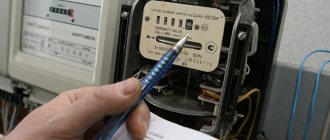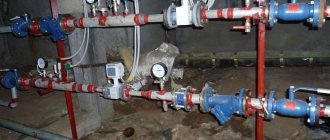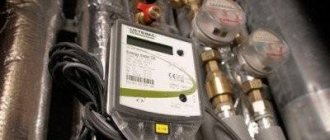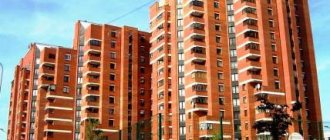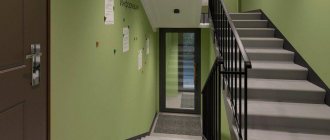What is ODN for electricity?
The easiest way to explain the meaning of this term is with an example. Let's say there is a standard apartment building connected to the power supply. The total expense in this case will include the following components:
- Electricity consumed by individual consumers.
- Electricity necessary to power the equipment of common home areas (lighting of stairwells, elevator equipment, technological losses on internal lines, etc.). This item of expenditure is called “general household needs” or abbreviated as GDN.
Consumption for the first item is determined according to the readings of individual meters. For the second, a special calculation is made, the results of which are reflected in the corresponding column of the utility payment receipt.
Receipt with column ONE electricity
What is the increasing coefficient for cold water supply on ODN?
The law obliges the installation of individual (IPU) or common house (ODPU) utility metering devices if the residential premises meet the appropriate technical specifications.
If they are absent in a building or apartment, an increasing factor is added to the housing and communal services consumption standards. For hot and cold water supply it is up to 1.6 since the beginning of this year.
An important condition for calculating this coefficient is the absence of a metering device in the apartment or house, if according to the technical characteristics it could be installed indoors.
If it was not technically possible to install such metering equipment, the amount of payment for the use of hot or cold water is determined according to the basic standard.
What is included in the ODN?
Residents of apartment buildings, having received a receipt that includes payment for one-time expenses, often wonder what this category of expenses includes. Let us answer this question by providing a drawing for clarity, listing common household appliances.
Equipment included in the ODN
Designations:
- a) Lighting fixtures in staircases, attics and basements.
- b) Lighting systems for local areas.
- c) Elevator equipment.
- d) Security systems (intercoms, video surveillance, etc.).
- e) Fire alarm.
- f) Providers' equipment.
- g) Antenna amplifiers.
- h) Pumping equipment.
- j) Electricity losses.
Please note that the last point includes both losses of the intra-house network and unauthorized connections that bypass individual devices that take into account electricity consumption. That is, in this case we can talk about stealing electricity from neighbors in the house.
Explanation of cold water supply, hot water supply and single use in the payment receipt
Payments collected for the provision of housing and communal services are fixed by Article 154 of the Housing Code of the Russian Federation.
A citizen who owns an apartment or has rented residential premises undertakes to make payments for hot and cold water, heat and electricity supply, gas supply and wastewater disposal, if he uses these services.
All of the above services are encrypted in the payment receipt in the form of abbreviations. This is done to make the document easier to read.
The following abbreviations are distinguished:
- Cold water supply - cold water supply;
- DHW – hot water supply;
- ODN - common house ones are needed;
- DPU – house metering device;
- KPU - apartment metering device;
- and others.
If you see the abbreviation HVS DPU on your payment receipt, it means the calculation of the amount required to pay for cold water supply, determined using the readings of a common house meter.
If the measuring equipment is installed directly in your apartment, the receipt should have a different abbreviation - HVS KPU.
In other words, the calculation of the amount required to pay for consumed cold water is based on the data of the individual apartment meter.
Payment for one day
According to the Decree of the Government of the Russian Federation (No. 354), the entire volume of electricity consumed at the ODN is paid by the residents of the multi-apartment residential building. To avoid any discrepancies, we present a verbatim excerpt from the Resolution.
An example of an excerpt from RF PP No. 354 dated May 6, 2011
As you can see, the Resolution stipulates that all electricity costs for one-way distribution systems are borne by the owners of the residential building, regardless of the chosen form of management. Guided by this Resolution, management companies calculate the volume of electricity consumption for general house needs, the results obtained are entered into utility payment receipts. An example of such a receipt was shown in Figure 1.
What is hidden under the abbreviation ODN
The abbreviation ODN hides the term “general household needs.” Apartment owners are required to pay not only for the maintenance of their housing, but also for other services:
- entrance lighting;
- power supply for elevators, intercom and pumping equipment;
- cleaning of entrances;
- cleaning communications;
- preparation for the heating season.
The question arises whether it is legal to charge one tax for sewerage. Most of the water supplied through pipes to apartments, after being used for laundry, dishwashing or hygiene purposes, is drained into the sewer system, which requires appropriate maintenance, just like the water supply system. The costs of this work must be borne by the residents themselves.
The more water we consume, the more we pay for the maintenance of the public sewer system.
ODN for sanitation depends on the actual volume of hot and cold water consumption, and not on the area of the apartment and the number of people registered in the apartment.
The readings of the device are influenced by the number of actual residents and their culture of water use. The more people, the higher the expense and payment costs. Thus, a single tenant of a three-room apartment pays less than three people in a one-room apartment.
Not everyone clearly understands what is included in the ODN for cold water. Water for general household needs is used for:
- cleaning of entrances;
- flushing the garbage chute;
- watering lawns;
- compensation for water supply losses.
Read more about the general expenses of apartment owners for the maintenance of a residential building in the article “What is included in general building needs.”
An example of calculating ODN for electricity in a multi-storey building
Despite the fact that tariffs and standards for electricity consumption differ in individual regions, the calculation formulas for calculating payments in the corresponding column remain unchanged. Let us give examples of calculations for a multi-apartment residential building with a common building meter for electricity consumption and an object where such a device is not available.
With counter
The calculation mechanism will be as follows:
- Readings are taken for a certain period from a common house electricity consumption meter. Let’s say the collective meter displays consumption of 6,500 kilowatt-hours. In this case, this is the total electricity consumption of a residential building, which includes the total volume of consumption of residential premises and the costs of one-room heating system.
- At this stage, a comparison is made of the total readings taken from individual electricity meters and the data from the common house meter. To perform this operation, it is necessary to sum up the consumption of each apartment. As a rule, data for the reporting period is collected on certain dates of the month. Such restrictions on the reading process are necessary to ensure that large discrepancies in the balance do not arise.
Let’s imagine that the total value of all residents’ electricity meter readings was 5,600 kilowatt-hours. That is, this is an indicator of the amount of electricity consumed by the owners of residential premises.
- Having received the consumption indicator for residential premises, it is subtracted from the total amount of electricity consumed. The result will be the number of kilowatt-hours per unit. In our case, the calculation will be as follows: 6500 – 5600 = 900.
- Now it is necessary to distribute (accrue) the ODN fee among the owners of the premises. Accruals are made to the owner based on the living space (RA) occupied by the apartment owners. For this operation, it is necessary to calculate the ratio between a square meter of housing and a unit of measurement for the resource spent on general house needs (kilowatt-hour for electricity).
Let's return to our example. Let's say the total living area in the house is 4200 m2. Therefore, in order to calculate the ratio, it is necessary to divide the total volume of ODN consumption (in our case 900 kWh) by the total amount of living space (4200 m2), we get: 900/4200 ≈ 0.214 kWh.
- Having calculated the ratio, it is easy to calculate the electricity consumption of one unit for any homeowner in the house. To do this, you need to multiply the resulting coefficient by the living area of a particular apartment. For example, if the owner has 42 m2 of living space, then the calculation of consumption, in our example, will be as follows: 42 * 0.214 = 8.988 kWh. Please note that the area of non-residential premises is not taken into account.
- At the final stage, the ODN fee is calculated; for this, the result obtained is multiplied by the tariff provided for the given region. Let's say our house is located in St. Petersburg, respectively, with a single-rate tariff of 4.32 rubles. for 1 kWh, the payment amount will be as follows: 4.32 * 8.988 ≈ 38.83 rubles.
- Payment is made for the consumption of electricity spent on general needs.
Closing the topic of calculations in the presence of a MOP meter, it should be noted that the weakest link in this accounting system is taking readings from individual devices. This is directly related to the influence of the human factor, for example, information was transmitted with an error or it is not possible to take readings due to the absence of residents. You should also take into account the time required to enter data into the common database and possible operator errors. Automated reading collection systems do not have such shortcomings. It will only take a few minutes to balance the electricity consumed by residents' networks, and 100% accuracy is guaranteed.
Without counter
The above method for calculating the consumption of resources (electricity) on one unit is applicable only if there is a common meter. If there is none, then a special standard provided for a given region is used as the coefficient necessary to calculate the use of electricity. The fee calculation principle is shown below.
Calculation of ODN in the absence of a common house meter
Information on the calculated coefficient (standard) for a specific region can be obtained on the official website of the regional administration. In this case, the coefficient acts as a limiting value; its revision is possible only upward. Such a decision can be made by a general meeting of residents (if we are not mistaken, in practice this has never happened before).
What are general house needs (CHN)?
Comments
Having received new invoices for payment of housing and communal services for September 2012, and for some for January 2013, many owners and users of premises in apartment buildings were unpleasantly surprised, because in addition to the usual payment for utilities, they saw new lines - utilities one.
What is ODN? Let's try to figure it out.
First of all, ODN stands for general house needs. Utilities ODN are utilities that are used in the process of maintaining common property in an apartment building.
These include costs for water supply, electricity supply, gas supply, heat supply (heating), which are used outside residential or non-residential premises in an apartment building and in accordance with the New rules for the provision of utility services, approved by Decree of the Government of the Russian Federation dated 05/06/2011 No. 354 “On the procedure for the provision of utility services” services to owners and users of premises in apartment buildings and residential buildings” must be paid for by all consumers, regardless of whether residential or non-residential premises are equipped with individual or common (apartment) meters.
Such public services include:
- technical losses in the intra-building engineering systems of water supply, electricity, gas supply, thermal energy and equipment of an apartment building (loss of utility resources in the event of accidents, flushing of engineering systems and their filling, hydraulic tests),
- cleaning and sanitary cleaning of premises included in the common property,
- improvement and maintenance of local areas (watering lawns, flower beds, maintenance of playgrounds, street lighting),
- lighting and heating of entrances, attics, basements,
- operation of elevators or other equipment that is common property, operation of intercoms, video surveillance systems, antenna equipment and much more.
The list of common property in an apartment building is determined by Article 36 of the Housing Code of the Russian Federation. This includes:
- inter-apartment landings,
- stairs,
- elevators,
- elevator and other shafts,
- corridors,
- technical floors,
- attics,
- basements with utility lines,
- other equipment serving more than one room in a given house (technical basements);
- other premises in this house that do not belong to individual owners and are intended to satisfy the social and everyday needs of the owners of premises in this house, including premises intended for organizing their leisure time, cultural development, children's creativity, physical education and sports and similar events,
- roofs,
- enclosing load-bearing and non-load-bearing structures of the house,
- mechanical, electrical, sanitary and other equipment located in a given house outside or inside the premises and serving more than one room,
- the plot of land on which this house is located, with elements of landscaping and landscaping,
- other objects intended for the maintenance, operation and improvement of this house and located on the specified land plot.
And now that we have decided what ODN is, it is time to figure out how it should be calculated for us.
The amount of payment for utilities provided for common house needs depends on the method of equipping an apartment building with common house (collective) metering devices.
Thus, in the presence of common house (collective) metering devices, the volume of utility services provided at the ODN is determined as the difference between the readings of the common house (collective) metering device, the readings of individual metering devices and consumption standards accrued for consumers who do not have individual meters.
This difference, if of course it is formed, is distributed among consumers in proportion to the total area of the occupied premises.
If there is no such difference, then fees for utilities are not charged, and may also cause the calculation of fees accrued in residential premises (apartments) if the volume according to the readings of a common house (collective) meter is less than the amount accrued for individual metering devices and standards.
In the absence of a common house (collective) metering device, the payment for utilities provided for common house needs will depend on the area of the premises included in the common house property and the consumption standard established for utilities provided for common house needs. This volume is also distributed among consumers in proportion to the occupied area.
Thus, we can draw the following conclusion: payment for common house needs is a mandatory component of payment for utility services, but such expenses can be controlled and regulated only if there is a common house (collective) metering device.
If such a metering device is not available in your apartment building, be prepared to bear monthly costs for utilities provided for general house needs, according to the standards that are approved for your region.
Which is more profitable with or without a meter?
As an example, let us give the norms of electricity consumption for general household needs for the Nizhny Novgorod region.
ODN consumption standards in Nizhny Novgorod (for example)
If you track thematic information on local forums, it turns out that installing MOS devices is profitable, since in this case you have to pay less for utility resources spent on general needs.
A situation where a common electricity meter is installed, and the volume of consumption of utility resources exceeds the regional norm, is fundamentally impossible. In this case, everything points to the fact of loss of resources due to the fault of the management company.
Calculation formulas
How the ODN for water is calculated depends on the presence/absence of a common house meter.
Lack of a common house appliance
In the absence of a common meter, the payment is calculated according to the standards, while the algorithm in accordance with each standard is given in the Order of the Ministry of Energy and Housing Complex. In schematic expression, the formula for calculating ODN for hot and cold water in this case looks like this:
Availability of a common house appliance
The total needs in the presence of a meter are the difference between the value shown by the common house meter and the total sum of the values of individual meters, together with the costs according to the standards in premises not equipped with meters. The resulting result is distributed in proportion to the occupied area among all owners. Accordingly, regardless of the number of people living in a multi-room apartment, the cost of one-room apartment will be greater than for a one-room apartment.
Common property - what is it?
List of objects included in the common property:
- stairs, landings;
- elevator rooms;
- attic spaces;
- basements;
- corridors;
- mines;
- roofs;
- strollers;
- premises used for common living (for example, vestibule) of apartment owners;
- the land on which the house itself is located and the area next to it;
- buildings on this land plot that are used to service the apartment building;
- load-bearing and other structures of the house;
- those. floors.
These premises are not part of anyone's property. They are intended for joint use by owners in apartment buildings.

